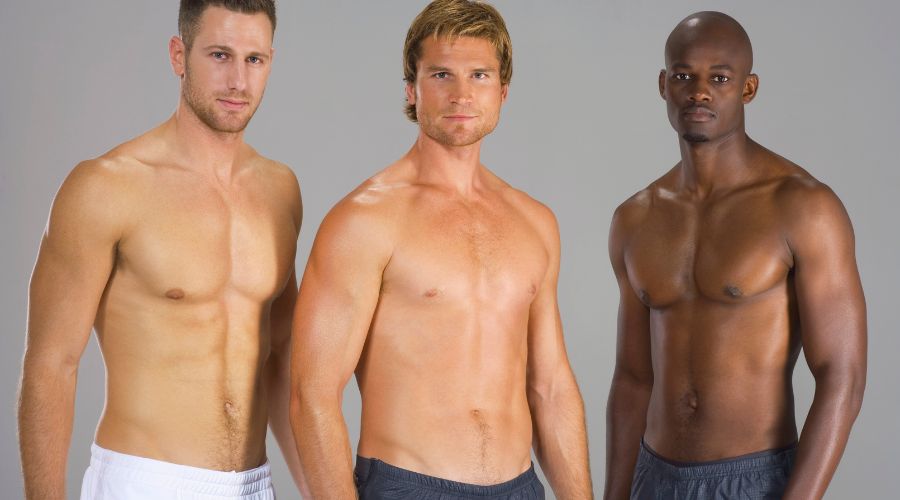Normally, the male chest is fairly flat with a slight contour and only has a minimal amount of breast tissue located in the nipple area. Sometimes men are afflicted with a condition that causes them to have an overabundance of breast tissue, which can cause discomfort and anxiety for these individuals. This condition is known as gynecomastia or “gyno” and can range from mild to severe.
Sometimes men appear to have gynecomastia because they look to have what some have dubbed “man boobs,” but their condition results from excess fat and is not glandular in nature. If you suffer from this condition, you are not alone, as 65% of adult males (even celebrities) have gynecomastia.
Today, we are going to look at some of the symptoms of gynecomastia, how to know if you have gyno or fat, and treatment options for each.
Where Does Gynecomastia Come From?
Many times, newborn baby boys have puffy nipples, which is an indication of gynecomastia and is caused by the excess estrogen passed from the mother to the baby. This normally goes away on its own by the time the child reaches 6 months of age.
It is also considered somewhat normal for gyno to show up during puberty when many teenage boys experience an imbalance in hormones. This often resolves on its own within a few years, and their testosterone levels rise and their estrogen levels decrease. If the condition has not gone away by the time the young man reaches age seventeen, a doctor should be consulted.
When symptoms of gynecomastia manifest in an older male, it could be related to a serious medical issue, and the cause should be investigated. Conditions that impact testosterone levels, such as liver or lung cancer, liver cirrhosis, hyperthyroidism, or cancer-related to the pituitary gland, adrenal gland, or testicular cancer, can cause symptoms of gynecomastia
Senior males can develop gyno symptoms due to the process of aging (andropause) and a decrease in their testosterone levels. This is similar to a woman entering menopause and experiencing a decrease in her estrogen levels.
Certain medications can also trigger gynecomastia, as can the use of recreational drugs like amphetamines, marijuana, heroin, and certain steroids. An excess in alcohol intake has also been linked to symptoms of gyno.
How Do You Know If You Have Gynecomastia?
Excess breast tissue that forms on a man’s chest can be caused by actual gynecomastia or a condition known as pseudo-gynecomastia. The difference between the two conditions is the presence of glandular tissue, which is the same type of tissue found in female breasts and causes their enlargement. It is normally more firm than fat and can accumulate in a mass underneath the nipple.
Symptoms Of Gynecomastia
Signs that can help you know if you have gyno or just fat include:
- Enlarged breasts;
- Tenderness;
- Pain;
- Breast tissue that is swollen;
- Nipples that are very sensitive (enough that clothing irritates them).
True gyno feels and looks similar to female breast tissue, with a more rounded shape. It is also firmer and not as jiggly as deposits of excess fat.
What Treatment Options Can Be Used To Eliminate The Signs Of Gyno?
A large portion of patients with gynecomastia can be treated with liposuction. The techniques used for liposuction have improved and evolved to be more effective yet gentler than previous liposuction procedures; however, choosing a surgeon skilled in lipo is critical to its success.
Usually, liposuction to treat gynecomastia is done using local anesthesia and involves the surgeon creating a few small incisions on each side of the chest, under the armpit, or around the edge of the areola to access the tissue to be removed. A special medical instrument is used that resembles a thin metal straw. and it is inserted into these incisions and used to vacuum out this extra fat, making this area of the chest flatter and more masculine-looking. Sometimes, liposuction is also performed on other areas of the chest to provide more contour and to create a more masculine and fit physique.
In some cases, surgery is necessary to remove the glandular breast tissue, as it is more fibrous and does not respond to liposuction. The degree of surgery needed will depend on how advanced the gynecomastia is and how much excess breast tissue is present. The surgeon will create incisions around the edge of the areola or along the natural chest creases and will excise excess glandular tissue and any loose, saggy skin. A surgeon skilled in this procedure will close these incisions with inconspicuous stitches to create minimal scarring.
What Kind Of Surgeon Can Remove The Signs Of Gynecomastia?
You should choose a highly skilled and board-certified cosmetic surgeon to perform your gynecomastia removal procedure. Whether you require liposuction alone or it combined with surgery, your results will be dependent upon the surgeon’s level of expertise in treating the symptoms of gyno. If gyno is not treated, the breast tissue may continue to enlarge, and breast pain and sensitivity can worsen. Additionally, because of the physical manifestation of female-type breasts, gyno can cause social anxiety and depression in men who have the condition.
If you want to know if you have gyno or chest fat, you should see your doctor to ensure you do not have an underlying medical condition. A cosmetic or plastic surgeon can help you get rid of the outward signs of gyno after the doctor identifies the cause.
Dr. Angelina Postoev of IBI Plastic Surgery & Med Spa is a triple board-certified cosmetic surgeon who can skillfully treat your gynecomastia symptoms and resculpt your chest to look more defined and masculine. After a male breast reduction, you will no longer have to be anxious or embarrassed in social settings, such as a day at the beach or pool, because your chest will be flat and contoured with no more female-looking breasts.
If you are embarrassed by female-looking breasts and want to know more about how you can tell the difference between gyno and fat, contact IBI Plastic Surgery & Med Spa. We have helped many patients obtain more sculpted, manly-looking chests and helped them regain their self-confidence. Set up an appointment today to find out if liposuction or surgery can help eliminate the signs of gynecomastia for you.







